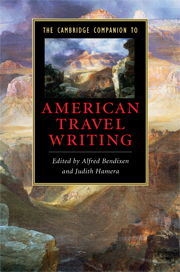Book contents
- Frontmatter
- Introduction: new worlds and old lands - the travel book and the construction of American identity
- Part I Confronting the American landscape
- Part II Americans abroad
- 6 American travel books about Europe before the Civil War
- 7 Americans in Europe from Henry James to the present
- 8 Americans in the Holy Land, Israel, and Palestine
- 9 Americans in the larger world: beyond the Pacific coast
- 10 South of the border: American travel writing in Latin America
- Part III Social scenes and American sites
- Chronology
- Further Reading
- Index
6 - American travel books about Europe before the Civil War
from Part II - Americans abroad
Published online by Cambridge University Press: 28 March 2009
- Frontmatter
- Introduction: new worlds and old lands - the travel book and the construction of American identity
- Part I Confronting the American landscape
- Part II Americans abroad
- 6 American travel books about Europe before the Civil War
- 7 Americans in Europe from Henry James to the present
- 8 Americans in the Holy Land, Israel, and Palestine
- 9 Americans in the larger world: beyond the Pacific coast
- 10 South of the border: American travel writing in Latin America
- Part III Social scenes and American sites
- Chronology
- Further Reading
- Index
Summary
During the early years of the nation and throughout much of the nineteenth century, patriotic Americans often deplored the idea of foreign travel. Even Washington Irving, who spent much of his adult life abroad and did more than any other author to establish the conventions of American travel writing about Europe, proclaimed in his A Tour on the Prairies (1835): “We send our youth abroad to grow luxurious and effeminate in Europe; it appears to me, that a previous tour on the prairies would be more likely to produce that manliness, simplicity, and self-dependence, most in unison with our political institutions.” Yet, Americans were eager to learn about the lands from which they were now separated by a revolution as well as an ocean. As citizens of the new world they were fascinated with what the old one had to offer: the chance to view the monuments to history, to gaze at great works of art, to visit sights associated with great writers, to wander through the graveyards and ruins of the past, and to ponder the meanings inherent in the symbols of other cultures. European travel was thus both attractive and dangerous for Americans throughout the early national period and the years leading up to the Civil War. The contradictory impulses underlying American travel in Europe during this time can be summed up by noting that almost every major American author made a statement condemning, ridiculing, or at least questioning the idea of foreign travel, and almost every one of them produced at least one travel book.
- Type
- Chapter
- Information
- The Cambridge Companion to American Travel Writing , pp. 103 - 126Publisher: Cambridge University PressPrint publication year: 2009

